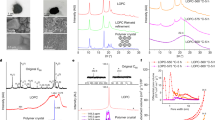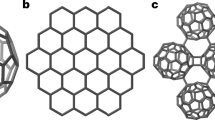Abstract
The discovery of nanostructured forms of molecular carbon has led to renewed interest in the varied properties of this element. Both graphite and C60 can be electron-doped by alkali metals1 to become superconducting; transition temperatures of up to 52 K have been attained by field-induced hole-doping of C60 (ref. 2). Recent experiments3,4 and theoretical studies5,6 have suggested that electronic instabilities in pure graphite may give rise to superconducting and ferromagnetic properties, even at room temperature. Here we report the serendipitous discovery of strong magnetic signals in rhombohedral C60. Our intention was to search for superconductivity in polymerized C60; however, it appears that our high-pressure, high-temperature polymerization process results in a magnetically ordered state. The material exhibits features typical of ferromagnets: saturation magnetization, large hysteresis and attachment to a magnet at room temperature. The temperature dependences of the saturation and remanent magnetization indicate a Curie temperature near 500 K.
This is a preview of subscription content, access via your institution
Access options
Subscribe to this journal
Receive 51 print issues and online access
$199.00 per year
only $3.90 per issue
Buy this article
- Purchase on Springer Link
- Instant access to full article PDF
Prices may be subject to local taxes which are calculated during checkout




Similar content being viewed by others
References
Hebard, A. F. et al. Superconductivity at 18 K in potassium-doped C60. Nature 350, 600–601 (1991).
Schön, J. H., Kloc, C. & Batlogg, B. Superconductivity at 52 K in hole-doped C60. Nature 408, 549–552 (2000).
Kopelevich, Y., Esquinazi, P., Torres, J. H. S. & Moehlecke, S. Ferromagnetic- and superconducting-like behavior of graphite. J. Low Temp. Phys. 119, 691–702 (2000).
Kempa, H. et al. Magnetic-field-driven superconductor-insulator-type transition in graphite. Solid State Commun. 115, 539–542 (2000).
González, J., Guinea, F. & Vozmediano, M. A. H. Electron-electron interactions in graphene sheets. Phys. Rev. B 63, 134421-1–134421-8 (2001).
Harigaya, K. The mechanism of magnetism in stacked nanographite: theoretical study. J. Phys. Condens. Matter 13, 1295–1302 (2001).
Narymbetov, B. et al. Origin of ferromagnetic exchange interactions in a fullerene-organic compound. Nature 407, 883–885 (2000).
Allemand, P. M. et al. Organic molecular soft ferromagnetism in a fullerene C60. Science 253, 301–303 (1991).
Mrzel, A. et al. Ferromagnetism in a cobaltocene-doped fullerene derivative below 19 K due to unpaired spins only on fullerene molecules. Chem. Phys. Lett. 298, 329–334 (1998).
Lobach, A. S. et al. C60H18, C60H36 and C70H36 fullerene hydrides: Study by methods of IR, NMR, XPS, EELS and magnetochemistry. Fullerene Sci. Technol. 6, 375–391 (1998).
Shul'ga, Y. M. et al. Magnetic properties of C60Pdn fullerides. Mol. Cryst. Liq. Cryst. 10, 201–206 (1998).
Ovchinnikov, A. A. & Shamovsky, I. L. The structure of the ferromagnetic phase of carbon. J. Mol. Struct. (Theochem) 83, 133–140 (1991).
Miller, J. S. & Epstein, A. J. Molecule-based magnets—An overview. Mater. Res. Soc. Bull. 25, 21–28 (2000).
Kahashi, M. et al. Discovery of a quasi-1D organic ferromagnet, P-NPNN. Phys. Rev. Lett. 67, 746–748 (1991).
Du, G., Joo, J., Epstein, A. J. & Miller, J. S. Anomalous charge transport phenomena in molecular-based magnet V (TCNE)x · y(solvent). J. Appl. Phys. 73, 6566–6568 (1993).
Iwasa, Y. et al. New phases of C60 synthesised at high pressure. Science 264, 1570–1572 (1994).
Núñez–Regueiro, M., Marques, L., Hodeau, J. L. & Perroux, M. Polymerized fullerite structures. Phys. Rev. Lett. 74, 278–281 (1995).
Sundqvist, B. Fullerenes under high pressures. Adv. Phys. 48, 1–134 (1999).
Makarova, T. L. et al. Anisotropic metallic properties of highly-oriented C60 polymer. Synth. Met. 121, 1099–1100 (2001).
Makarova, T. L. et al. Electrical properties of two-dimensional fullerene matrices. Carbon 39, 2203–2209 (2001).
Makarova, T. L. et al. in Fullerenes Vol. 7, Recent Advances in the Chemistry and Physics of Fullerenes and Related Materials (eds Kadish, K. M., Guldi, D. M. & Kamat, P. V. ) 628–639 (Proceedings series PV 99-12, Electrochemical Society, Pennington, New Jersey, 1999).
Makarova, T. L. et al. Conductivity of two-dimensional C60 polymers. Mol. Cryst. Liq. Cryst. C 13, 151–156 (2000).
Davydov, V. A. et al. Spectroscopic study of pressure-polymerized phases of C60. Phys. Rev. B 61, 11936–11945 (2000).
Luo, W. L., Wang, H., Ruoff, R. C., Cioslowski, J. & Phelps, S. Susceptibility discontinuity in single-crystal C60. Phys. Rev. Lett. 73, 186–188 (1994).
Haddon, R. C. et al. Experimental and theoretical determination of the magnetic susceptibility of C60 and C70. Nature 350, 46–47 (1991).
Wang, X. K., Chang, R. P. H., Patashinski, A. & Ketterson, J. B. Magnetic susceptibility of buckytubes. J. Mater. Res. 9, 1578–1582 (1994).
Panich, M., Shames, A. I. & Nakajima, T. On paramagnetism in fluorinated graphite: EPR and solid state NMR study. J. Phys. Chem. Solids 62, 959–964 (2001).
Saito, T., Akita, Y. & Tanaka, K. Magnetic susceptibility of the one-dimensional polymeric phase of RbC60. Phys. Rev. B 61, 16091–16096 (2000).
Pekker, S., Forro, L., Mihaly, L. & Janossy, A. Orthorhombic A1C60—a conducting linear alkali fulleride polymer. Solid State Commun. 90, 349–352 (1994).
Xu, C. H. & Scuseria, G. E. Theoretical predictions for a 2-dimensional rhombohedral phase of solid C60. Phys. Rev. Lett. 74, 274–277 (1995).
Acknowledgements
We thank R. Blinc for discussions, W. Frech for help with impurity analysis, and A. L. Shelankov for comments on the manuscript. This work was done in the framework of a project supported by the Alexander von Humboldt Foundation (T.L.M.). Part of this work was supported by the DFG and FAPESP. B.S. thanks the Swedish Research Council for support.
Author information
Authors and Affiliations
Corresponding author
Supplementary information
41586_2001_BF35099527_MOESM1_ESM.mpg
Some of our samples show a sufficiently strong magnetisation that they can be lifted off a table surface using a small SmCo magnet (MPG 3835 kb)
Rights and permissions
About this article
Cite this article
Makarova, T., Sundqvist, B., Höhne, R. et al. Magnetic carbon. Nature 413, 716–718 (2001). https://doi.org/10.1038/35099527
Received:
Accepted:
Issue Date:
DOI: https://doi.org/10.1038/35099527
This article is cited by
-
Highly in-plane anisotropic optical properties of fullerene monolayers
Science China Physics, Mechanics & Astronomy (2023)
-
Ferromagnetism in sp2 carbon
Nano Research (2023)
-
Synthesis of a monolayer fullerene network
Nature (2022)
-
Organic magnetoelectric and optomagnetic couplings: perspectives for organic spin optoelectronics
NPG Asia Materials (2021)
-
Effect of defects controlled by preparation condition and heat treatment on the ferromagnetic properties of few-layer graphene
Scientific Reports (2017)
Comments
By submitting a comment you agree to abide by our Terms and Community Guidelines. If you find something abusive or that does not comply with our terms or guidelines please flag it as inappropriate.



